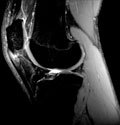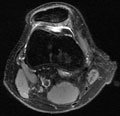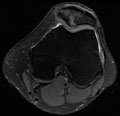Higher resolution MRIs show more knee damage in asymptomatic athletes
A recently presented study using 3T MRI revealed more injuries in the asymptomatic knees of basketball players than previous reports using MRIs with weaker magnet strengths.
“The prevalence of asymptomatic MR findings in basketball players is greater than what has been reported in the literature when we use these more powerful magnets,” Marc R. Safran, MD, said during his presentation at the 2011 Annual Meeting of the American Orthopaedic Society for Sports Medicine. “But the real issue is to make the clinician take caution when interpreting MRIs of athletes.”
Safran and colleagues studied 12 male and 12 female college basketball players who underwent 3T MRIs with clinical proton sequences to look for cartilage meniscus and ligament pathology, and T2-weighted MRIs to check for edema.
All of the patients completed a subjective questionnaire prior to imaging to ensure they had no previous history of knee problems or surgeries.
“Our goal was to confirm prevalence of MRI identified pathology, but using a higher resolution,” Safran said. “We also wanted to see what happens over the course of a season in both men’s and women’s collegiate basketball.”
|
|
|
Images: Safran MR |
‘Striking’ findings
“What we found was pretty striking,” Safran said.
The investigators found that 71% of athletes had chondral damage, 75% showed evidence of bone marrow edema and 83% had changes in the patellar tendon. The researchers found no meniscal tears, but Safran noted that 41% of athletes had grade 1 or 2 meniscal changes. One male and one female athlete had a meniscal capsular separation. None of the patients had ligament injuries.
Season-long changes
At the end of the season, the investigators found that the same percentage of athletes had chondral damage. They also found that more than a third of the men and women showed increased MRI chondral changes after a season of basketball.
The study revealed that 86% of patients at the end of the season had marrow edema, 90% had patellar or quadriceps tendinopathy and 40% had changes in the meniscus. One player had a change of meniscal capsular separation. There were no ligament injuries.
The investigators also reviewed previously published studies that investigated basketball players who underwent MRIs “using a 1.5 T unit or weaker,” Safran said. These included one study of 12 male and five female college basketball players, and two studies involving National Basketball Association players only.
The investigators found a higher prevalence of chondral injuries, and patellar and quadriceps tendon changes both preseason and postseason in their study compared with published reports. – by Renee Blisard
Reference:
- Safran MR, Pappas G. Vogelsong M, et al. Prevalence of asymptomatic findings in collegiate basketball players using 3T MRI and change over the course of one season. Paper #38. Presented at the 2011 Annual Meeting of the American Orthopaedic Society for Sports Medicine. July 7-10. San Diego.

- Marc R. Safran, MD, can be reached at Stanford Medicine Outpatient Center ORS, 450 Broadway St., Redwood City, CA 94063; (650) 721-3470; email: msafran@stanford.edu.
- Disclosures: Safran has no relevant financial disclosures.




